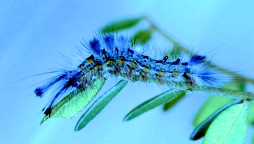PESTS AND DISEASES OF FORESTRY IN NEW ZEALAND
Latest survey unearths only one painted apple moth site
From Biosecurity Issue 21, August 2000.
MAF is continuing its response to the incursion of painted apple moth (Teia anartoides) in Auckland, first detected 15 months ago. Following a range of measures taken by MAF to eradicate the pest, the most recent survey has identified only one site of live infestation.
Painted apple moth is native to Australia, and has the potential to establish over a large part of New Zealand. The moth’s broad host range, and its ability to severely defoliate host vegetation, suggests that it could seriously impact on our forestry, horticultural and conservation sectors if it was to become established here.
First spotted by member of public

Painted apple moth was identified in the Auckland suburb of Glendene in May last year, following a report from a member of the public. Almost five months later, a second infestation was detected some 15 kilometres away in Mt Wellington – again as the result of a public report.
The distance between these locations makes it unlikely that the second infestation resulted from natural dispersal. Female adults cannot fly, and the primary means of natural spread is through young larvae “ballooning” on light air currents. Spread by this means is limited, but painted apple moth does lay eggs and pupate on inanimate objects such as cars. Human intervention can therefore aid its spread.
Larvae feed on wide range of plants
In Australia, larvae of the painted apple moth have been recorded feeding on and damaging a wide range of host plants. The moth has a particular preference for Acacia spp. and brush wattle, but will also attack economically important plants such as radiata pine and pip and stone fruit trees.
In New Zealand, painted apple moth has been observed feeding on a number of additional hosts, including a native kowhai which was almost completely defoliated.
Surveys
In the initial stages of the MAF response, delimiting surveys were carried out to determine the geographical distribution of both infestations. Around 1,300 sites were inspected at each location. Follow-up surveys are carried out at intervals of six to eight weeks. To date, eight follow up surveys have been completed in Glendene, and five in Mt Wellington.
Measures to eradicate moth
In addition to the surveys, MAF’s response has involved:
- ground spraying host trees on known infested sites (and sites close to known infested sites) with the insecticides chlorpyrifos and deltamethrin;
- removing selected host material to reduce potential habitat;
- issuing restricted place notices under the Biosecurity Act 1993, and preventing the removal of vegetation and other risk items from these sites; and
- providing for the safe disposal of vegetation through the provision of a free garden rubbish removal service. The effectiveness of treatments is monitored through weekly checks of sites where painted apple moth has been detected, and the periodic full follow up surveys.
The most recent follow-up survey (3-7 July 2000) identified only one site on which live painted apple moth was found in Glendene, and revealed no new sites of live infestation in the Mt Wellington area.
Ruth Frampton, Director Forest Biosecurity, MAF Forest Biosecurity

 Farm Forestry New Zealand
Farm Forestry New Zealand

